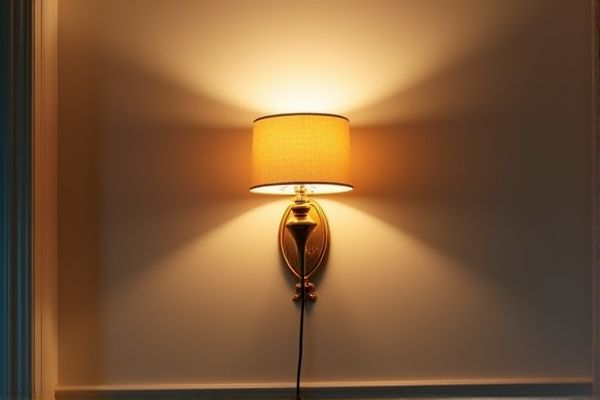
Wall sconces provide a sleek, space-saving lighting solution that enhances room ambiance without occupying surface area, while plug-in lamps offer flexible placement and easy installation at the cost of visible cords and plugs. To explore which lighting option best suits Your style and functionality needs, read the rest of the article.
Table of Comparison
| Feature | Wall Sconces | Plug-in Lamps |
|---|---|---|
| Installation | Permanently mounted on walls, requires wiring or battery-powered options | Portable, plugs directly into electrical outlets, no installation needed |
| Space Efficiency | Saves floor and table space, ideal for small rooms | Occupies floor or table space, depends on lamp size |
| Lighting Type | Provides ambient or accent lighting, fixed direction | Offers task or ambient lighting, adjustable positions |
| Power Source | Hardwired or battery-operated | Electric outlet-powered |
| Design Versatility | Variety of styles, enhances wall decor | Wide range of designs, often decorative and functional |
| Cost | Generally higher upfront due to installation | Lower initial cost, no installation required |
| Mobility | Fixed location | Movable and repositionable |
Introduction to Wall Sconces and Plug-In Lamps
Wall sconces provide fixed lighting solutions mounted directly on walls, offering a stylish and space-saving option for illumination. Plug-in lamps offer flexible lighting with the convenience of being easily moved and plugged into any standard outlet, ideal for adaptable lighting needs. Understanding the differences helps you choose the most suitable lighting based on your room design and functionality requirements.
Design and Aesthetic Appeal
Wall sconces offer a sleek, space-saving design that seamlessly integrates into your room's architecture, providing ambient or accent lighting without occupying floor or table space. Plug-in lamps boast versatile styles and portability, allowing you to easily change location and customize lighting intensity according to your needs. Choosing between the two depends on your preference for a permanent, streamlined fixture versus flexible, decorative lighting options.
Installation Process and Flexibility
Wall sconces require permanent installation, often involving electrical wiring and mounting, making them a more fixed lighting option ideal for long-term setups. Plug-in lamps offer superior flexibility with easy placement and no hardwiring, allowing you to move or adjust lighting according to your needs without professional assistance. Your choice between the two depends on whether you prioritize a sleek, built-in look or adjustable, hassle-free lighting solutions.
Space-Saving Solutions
Wall sconces provide a space-saving lighting solution by being mounted directly on walls, freeing up floor and table surfaces for other uses. Plug-in lamps require surface space for placement and accessible outlets, which can limit arrangement flexibility in smaller rooms. Choosing wall sconces can enhance room aesthetics without cluttering valuable living areas, making them ideal for compact spaces.
Lighting Efficiency and Coverage
Wall sconces provide focused, upward or downward lighting that enhances ambient atmosphere while saving floor space, offering efficient illumination for hallways and accent walls. Plug-in lamps deliver versatile, localized lighting with adjustable placement, efficiently brightening task areas like desks or reading nooks. Your choice impacts lighting coverage and energy use, with wall sconces typically illuminating broader areas and plug-in lamps targeting specific spots.
Electrical Considerations and Safety
Wall sconces require professional electrical wiring and are hardwired into your home's electrical system, which ensures a clean look but demands adherence to local electrical codes and permits for safety. Plug-in lamps offer flexible placement with simple access to power outlets, reducing installation risks and allowing easy removal or relocation. Your choice impacts both convenience and electrical safety, so consider the wiring complexity and compliance with safety standards when selecting between these lighting options.
Cost Comparison
Wall sconces generally involve higher upfront costs due to installation expenses, including electrical wiring and labor, whereas plug-in lamps offer a more affordable, flexible option with no installation required. Your budget will also affect ongoing costs, as wall sconces can reduce electricity use by providing targeted lighting, while plug-in lamps may increase energy consumption if used inefficiently. Considering both purchase price and long-term energy savings ensures the best choice for your lighting needs.
Versatility and Portability
Wall sconces offer fixed placement that enhances room ambiance without occupying floor space, making them ideal for permanent lighting solutions; plug-in lamps provide greater versatility and portability, allowing easy relocation and adjustment for task lighting or accent purposes across multiple rooms. The hardwired nature of wall sconces limits flexibility in repositioning, whereas plug-in lamps can be moved effortlessly to adapt to changing decor or functional needs. Portability in plug-in lamps supports dynamic lighting arrangements, while wall sconces contribute to stable, decorative illumination.
Maintenance and Longevity
Wall sconces typically require less frequent maintenance due to their fixed installation and durable materials, ensuring longer service life with minimal upkeep. Plug-in lamps often need more attention because of their flexible placement, potential for cord damage, and bulb replacements occurring more frequently. Investing in high-quality wall sconces can result in improved longevity compared to the mobility-prone wear and tear of plug-in lamps.
Choosing the Right Option for Your Space
Wall sconces provide a permanent lighting solution that enhances room ambiance and saves floor space, ideal for hallways and living rooms with limited surface area. Plug-in lamps offer flexibility and portability, allowing easy relocation to suit changing decor or varying lighting needs in bedrooms or home offices. Consider room size, electrical outlet availability, and desired lighting style to select the option that best complements your spatial layout and functional requirements.
 homyna.com
homyna.com